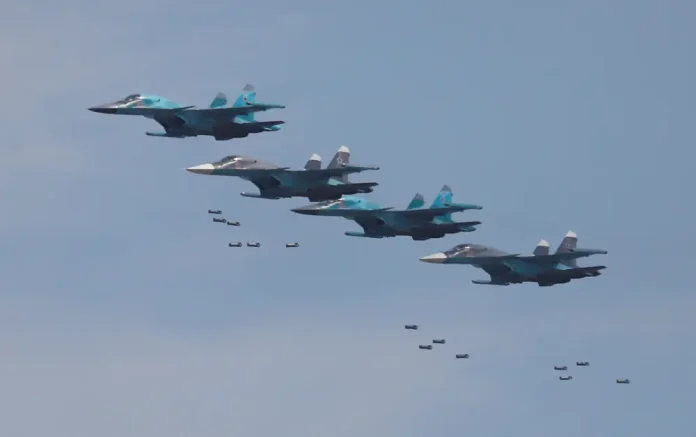A 1,500-kilogram winged bomb was spotted in the Ukrainian town of Krasnohorivka near the front line, less than 20 miles from the eastern city of Donetsk, according to The Independent.
Images of the complete destruction of a building provide one of the latest examples of Russia’s new weapons, devastating to Ukrainian defensive positions on the front line. Russian forces have reportedly intensified their offensive in eastern Ukraine as the war-torn country faces a shortage of weapons and ammunition, with Western allies delaying new funding and military aid.
Ukraine also uses guided bombs similar to Russia’s newly modified FAB-1500 warheads, known as the joint direct attack munition system (JDAM). However, the stockpile of US-made weapons is much more limited than Russia’s.
John Foreman, the former UK defence attache to Moscow, describes the FAB as less effective than the JDAM but a much cheaper weapon ultimately more accessible to Russian forces than the JDAM is to Ukraine.
Fundamentally, they’re dumb unguided Soviet-era bombs with smart winglets added to them to attack fixed targets with a degree of precision.
The Russian warhead is a modified version of Soviet-era FAB bombs, the first of which, the FAB-250, was designed in 1946. These air-dropped warheads, carried by fighter aircraft, have a significant explosive impact. However, unlike its predecessors, it was equipped with wings that allowed it to fly towards the target, thus turning it into a guided explosive.
The FAB-1500 includes 675 kg of explosives, can be launched between 40 and 70 km away from the target and has a striking radius of 200 metres, forcing Ukrainian forces to use longer-range interceptor missiles, which are available in smaller numbers. The bomb’s course can also be adjusted by satellite or laser navigation, increasing its accuracy.
When Russian Defence Minister Sergei Shoigu visited an arms factory suspected of producing those FABs in January, the director of the plant claimed that productivity had increased by 40 percent, having switched to round-the-clock operation.
Maksym Zhorin, the deputy commander of Ukraine’s 3rd Separate Assault Brigade, who were among the last soldiers left in Avdiivka before it fell, described how Russia was dropping 60 to 80 such bombs every day.
These bombs completely destroy any position. All buildings and structures simply turn into a pit after the arrival of just one.
Ukraine is trying to deal with the threat in the best way possible. Faced with difficulties in dealing with the bombs that have been launched, they hope to disrupt the aircraft delivering them as a priority. The Ukrainian military argues that the delivery of US F-16 fighter jets will ease the problem by making it more risky for the Russian planes tasked with delivering the bombs.
However, some analysts, including Bronk, the think tank analyst, assure that “F-16s are unlikely to provide any significant improvement in interception capabilities against Russian glide bomb attacks.”
“The fighters and strike fighters lofting the glide bombs are doing so at release distances many tens of kilometres behind the Russian front lines, meaning F-16 pilots would need to get far too close to Russian ground-based SAM threats to reliably engage them. Even then, they would need to be in exactly the right place at exactly the right time to acquire and fire on a Russian jet just as it started to climb for a lofting release.”
Without additional Western military support packages, Ukraine cannot achieve much. As Kyiv has repeatedly stated, it urgently needs active efforts by its Western allies.
